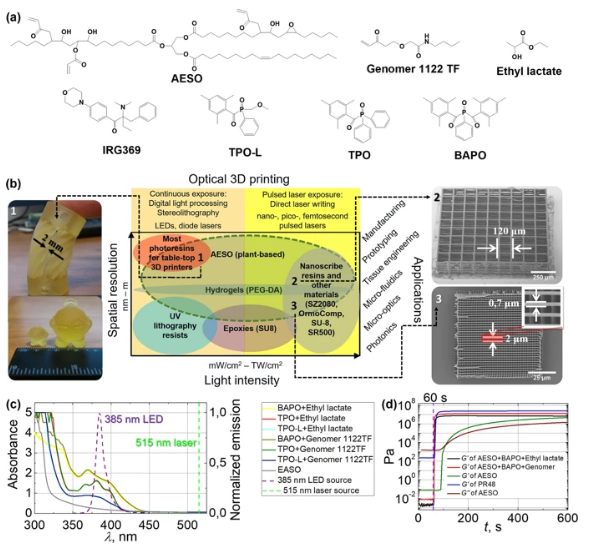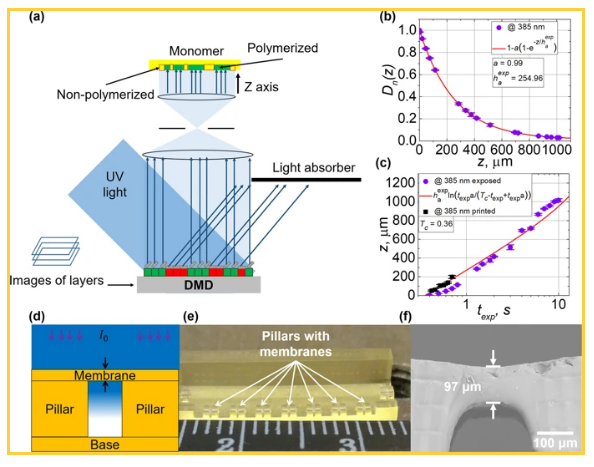Lithuanian researchers, in collaboration with 3D Creative Ltd., have developed a universal bio-based resin for optical 3D printing, releasing the details of their study in the recently published “A Bio-Based Resin for a Multi-Scale Optical 3D Printing.” In years past, petroleum-based materials have been extremely popular for use in additive manufacturing, but now researchers around the globe have a more definitive focus on renewable sources.
Optical 3D printing (O3DP), while generally still used with petroleum-derived resins, offers affordability and efficiency in production, along with a decreased amount of material waste. In this study, the researchers attempted to break free of petroleum products—and the limitations of conventional manufacturing—developing a new resin from soybeans that can be used on the nano- and macro-scale, as well as processed without a photoinitiator.
O3DP, accompanied afterward by post-processing in the form of thermal treatment, allows users to create structures and prototypes for objects made of materials like:
- Ceramic
- Pure glass
- Metal
- Crystalline

Potential applicability and characteristics of AESO. (a) – chemical structures of AESO, diluents Genomer 1122TF and ethyl lactate, PIs IRG369, TPO-L, TPO and BAPO. (b) – an explanation chart for the materials used in optical 3D lithography: Y-left axis – achievable spatial resolution, Y-right – available applications, X-top – required equipment, X-bottom – required irradiation intensities. Images of the objects produced out of AESO-based resin using both DLP and NLL technologies are shown. The numbers 1–3 are marked on the chart to represent how the objects were produced and indicate their potential applications. (c) – measured AESO, AESO + PI(1% w/w)+diluent absorbance and normalized light source emission spectra. Green dashed vertical line marks the wavelength of the laser source. (d) – the dependencies of storage modulus G’ of AESO, AESO-based resins, and PR48 on irradiation time43,64. The onset of irradiation (60 s) is marked with violet vertical dashed line.
“Additionally, O3DP offers flexible manufacturing of multi-scale (multi-dimensional) hierarchical or arbitrary structures which allows speeding up the printing yet keeping the nano-/micro-functionalities available in macro-dimensional objects suitable for diverse practical applications,” stated the authors.
During O3DP, light travels through materials being used and is absorbed either linearly or non-linearly:
“While the former ensures high throughput and rapid manufacturing of macro-scale objects, the latter allows high spatial resolution fabrication in micro-scale and true 3D structuring.”
A variety of polymerization machines have been created to experiment with the advantages of both micro- and macro-scale 3D printing:
- Table-top devices
- Custom-made prototypes
- Advanced scientific setups
- Industrial setups

Assessment of the exposure conditions for the DLP lithography and obtained results. (a) – a scheme of the DLP lithography. DLP experiments data using AESO + BAPO + Genomer 1122TF resin. (b) – normalized energy dose Dp dependence on polymerized films height z. (c) – polymerized films height z dependence on exposure duration texp. (d) – a model of a single layer membrane on the pillars. (e) – the model produced out of AESO based resins. (f) – printed membrane: theoretical height 102 μm, measured 97 μm (SEM image). Values of the measured thicknesses of the printed membranes (five black squares) are shown in picture (c).
The authors explain that while both types of photopolymerization have been well-studied, there is a new focus and demand on O3DP material in relation to functionality—as well as the use of bio-products that are environmentally friendly.
“Usually, the material is proper only for one technological fulfillment because of its properties, for example, optical characteristics, viscosity, impurities, sensitivity to development and post-processing, photopolymerization mechanism, etc.,” explained the authors.
In this study, the scientists were able to show that bio-based, acrylated epoxidized soybean oil (AESO) offered greater benefits than the typical resins being used today in O3DP:
“As rheological (storage modulus, loss modulus, viscosity) and optical (absorption) properties of AESO were easily modified by mixing it with diluents and PIs, we showed propriety of custom made resins for two technological implementations, enabling to produce multi-scale (from hundreds nm to cm) objects from a single material,” said the authors. “In general, AESO has a great potential to be straight-forwardly applied in a multi-scale fabrication, employing O3DP technologies, which is a naturally evolving development direction.”

Manufacturing via NLL and obtained results. (a) – a model of 75 × 75 μm2 size bi-layer scaffold structure: T – 30 μm period, p – 15 μm log width, l – 75 μm log length, d – 15 μm distance between logs, dxy – distance between scans, H – 20 or 30 μm vertical column height, h – 5 μm height between separate column segments, P – applied laser power, v – scanning velocity. (b) – SEM image (at 45° angle) of arrays of manufactured scaffold structures out of AESO. Applied average P was 0.4–0.8 mW (recalculated to intensity I 1.2–2.4 mW/cm2) and is represented in white scale at the bottom. dxy is shown on the black scale at right. v was set to 5 mm/s. The green area marks well-shaped objects and the red – deformed ones or only their residuals. (c) – representation of the “resolution bridges” (RB) method and ellipsoid shape voxel (green) at the 2w0 diameter laser beam focal plane. D and L are lateral and longitudinal dimensions of the voxel. (d) – demonstrates a measurement of RB lateral D size (top view). Applied v to form beams was set to 1 mm/s, P was altered in the range 0.1–0.6 mW. (e) – 2D grating in AESO + 0.5% w/w IRG369, v = 0.15 mm/s, P = 0.12 mW, h = 1 μm. D and L sizes are represented in upper-right and lower-left insets, respectively. (f) – 1.065 × 1.065 mm2 size 7 layers scaffold: p = 25 μm, d = 105 μm, v = 5 mm/s, P = 0.6 mW; SEM images (at 45° angle) of objects fabricated using P = 0.18 mW: (g) – “Car” model: v = 1.8 mm/s, dxy = 0.15 μm; (h) – “Tower” model: v = 1.2 mm/s, dxy = 0.15 μm; (i) – “Marvin” model: v = 1.2 mm/s, dxy = 0.25 μm. For fabrication of the objects in pictures (b) and (f) 20 × 0.8 NA objective was used, for (d–e) and (g–i) – 63 × 1.4 NA.
The study of materials is expansive today, especially with the continued use of polymers, resins, and a range of composites. What do you think of this news? Let us know your thoughts! Join the discussion of this and other 3D printing topics at 3DPrintBoard.com.
[Source / Images: ‘A Bio-Based Resin for a Multi-Scale Optical 3D Printing’]
The post Soybean-Based Resins to Replace of Petrochemicals for Optical 3D Printing appeared first on 3DPrint.com | The Voice of 3D Printing / Additive Manufacturing.
from Your daily news from 3DPrint.com https://bit.ly/2Z9nerX

